Ground cover plants are extremely useful in landscaping.
They’re low-maintenance landscaping solutions to common problems and questions like:
- What should I plant on a slope that’s too steep for my lawnmower?
- What will grow under a shady tree with prominent roots?
- How can I create a uniform border along my driveway?
- What can I plant that I can walk on, without having to mow?
And ground covers that bloom are not just functional – some are stunning!

We link to vendors to help you find relevant products. If you buy from one of our links, we may earn a commission.
Here’s an idea:
Look at your front lawn. If it’s like mine was, it’s a sea of green waiting to be thatched, seeded, fertilized, watered, and mowed, on a rotating basis, year in, year out.
Why not remove one section of grass and replace it with a low-maintenance focal point that is especially lovely when it’s in bloom?
Read on to discover 15 flowering ground covers that are sure to make your outdoor space more attractive, and your yardwork easier.
Here is the lineup:
Our Favorite Flowering Ground Covers
- Bugleweed (Ajuga reptans)
- Canadian anemone (Anemone canadensis)
- Candytuft (Iberis sempervirens)
- Creeping Phlox (Phlox subulata)
- Creeping Thyme (Thymus praecox)
- Deadnettle (Lamium maculatum)
- Hosta (Hosta sieboldiana)
- Horned Violet (Viola cornuta)
- Japanese Pachysandra (Pachysandra terminalis)
- Liriope (Liriope spicata)
- Lithodora (Lithodora diffusa)
- Pig Squeak (Bergenia cordifolia)
- Spike Speedwell (Veronica spicata)
- Sweet Woodruff (Galium odoratum)
- Wishbone Flower (Torenia fournieri)
Some ground covers are only a few inches tall, and others top out at two feet or more.

What qualifies them for this category is not their height, but their function:
To form interconnected mats via creeping or clumping that crowd out weeds and form a continuous expanse of foliage.
If you’re thinking of converting a lawn area to a network of creeping or clumping plants, be sure to consider the need for pathways to facilitate movement through your landscape.
Also, before planting any creeping or clumping plant, particularly those that claim to be fast growing, refer to the USDA list of Introduced, Invasive, and Noxious Plants. What is desirable in one state may be considered a nuisance in another.
1. Bugleweed (Ajuga reptans)
Perennial bugleweed (Ajuga reptans) is a member of the mint family that readily naturalizes in Zones 3 to 10, growing best in average to moist soil, with full sun to partial shade.

In warmer climates, this plant is evergreen.
Topping out at six inches, it derives its name from spikes of tiny bugle-shaped blossoms that range in color from blue to white.
The leaves of this plant are glossy, toothed or smooth, and often tinged with shades of purple. Bloom time is May through June.
Nature Hills offers A. reptans ‘Black Scallop’ in one-gallon pots.
2. Canadian anemone (Anemone canadensis)
Perennial Canadian anemone (Anemone canadensis) is a US native wildflower that spreads well in Zones 3 to 8, prefers moist soil, and thrives in full sun to part shade.
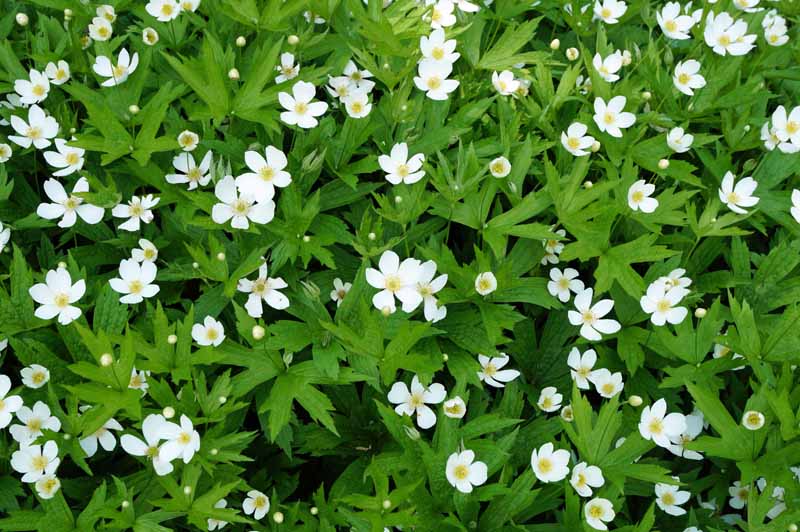
Its height varies from one to two feet. Blossoms are individual and white in color, and leaves are bright green with toothed edges.

Canadian Anemone Native Wildflower Seeds
You can find 150 Canada anemone native wildflower seeds from Everwilde Farms via Amazon.
3. Candytuft (Iberis sempervirens)
Candytuft (Iberis sempervirens) is a woody, mounding perennial that likes full sun and well-drained soil, and tolerates drought.
It’s suitable for Zones 3 to 8, and reaches a height of about 12 inches. In warmer climates, this plant is evergreen.

The blossoms of candytuft consist of sweetly scented clusters of white petals, which are often so profuse that you can’t see the elongated green leaves below. Bloom time is April through May.
You can find packets of 100 or 1,000 seeds available from True Leaf Market.
4. Creeping Phlox (Phlox subulata)
Creeping phlox, or moss phlox, makes a bold statement as a carpet of color in shades of pink, blue, or white. Leaves are small and evergreen.
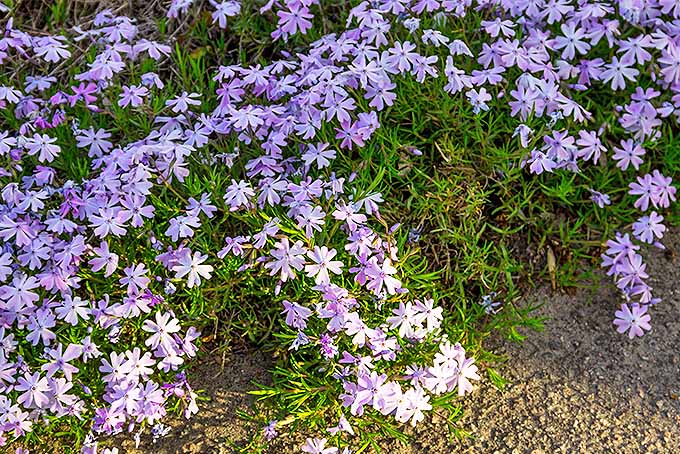
It stands up to light foot traffic and is lovely cascading over slopes and garden walls. This is a native variety suitable for Zones 3 to 9 that is perennial in most regions.
Plants are about two inches tall, and may exceed six inches when in bloom, during March through May. Provide sun to part shade, with average soil and moisture.

Phlox Subulata ’Drummond’s Pink’
P. subulata ‘Drummond’s Pink’ is available from Nature Hills Nursery in #1 containers.
Read more about growing and caring for creeping phlox here.
5. Creeping Thyme (Thymus praecox)
Creeping thyme (Thymus praecox) is a wild variety of the herb that is wonderful between stepping stones. Light foot traffic releases a delightful minty aroma.

Hardy in Zones 4 to 8, this woody perennial likes well-drained dry to average soil and full sun. It’s drought tolerant, and evergreen in mild climates.
Reaching approximately three inches in height, this plant has tiny, round, glossy green leaves and spikes of tiny pink-purple blossoms from June through July.
Nature Hills offers T. praecox ‘Coccineus’ in one-gallon containers.
Consult “Tasty Turf: Tips for Using Culinary Herbs as Ground Cover” for more ideas on using herbs in your landscape.
Learn more about how to grow creeping thyme in our guide.
6. Deadnettle (Lamium maculatum)
Lamium maculatum thrives in Zones 3 to 8 in part to full shade. It is evergreen in temperate zones. Leaves are variegated green and silvery-white, and pink blossoms appear from May through July.
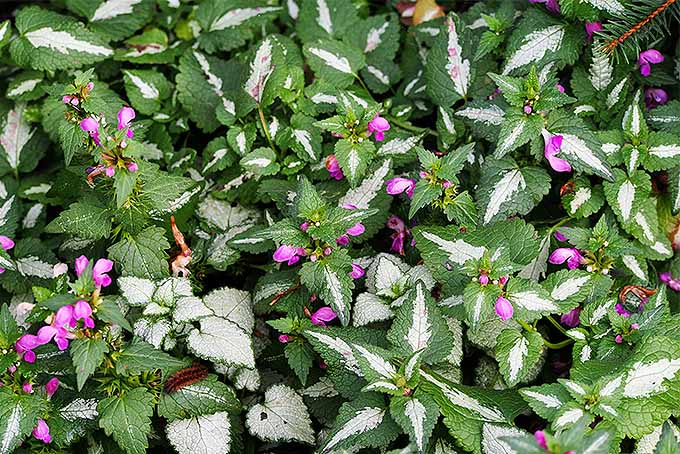
This drought-tolerant plant prefers cool, low-humidity regions with well-drained soil.
Varieties vary in height from several inches to about two feet, grow in a clumping or creeping fashion, and form an interconnected network that crowds out weeds and inhibits soil erosion.
The shorter varieties are great for those narrow spaces in between paving stones, as well as in rockeries and border gardens, where you want to inhibit weed growth.
L. maculatum ‘Purple Chablis’ features purplish-pink flowers, and reaches a mature height of eight to 12 inches, with a two-foot spread.
You can find ‘Purple Chablis’ available from Nature Hills Nursery.
7. Hosta (Hosta sieboldiana)
Reliable perennials, hosta leaves vary from forest to lime green, to variegated green and white, to all white.
Blooming is inflorescent in nature, with tall spikes of small white or purple blossoms appearing from May through July. Some varieties are sweetly scented.
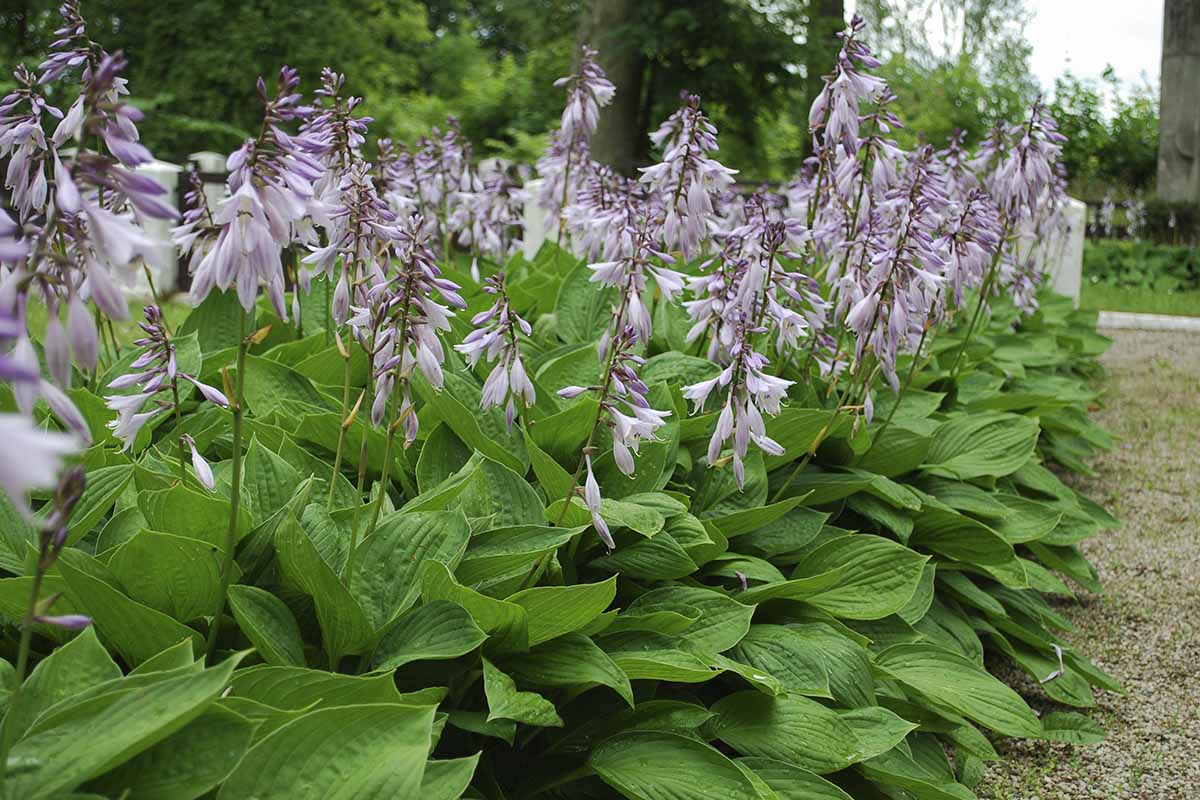
Also called plantain lilies, hostas have always been a staple in my family’s gardens. My great-grandmother had enormous plants with foot-long dark green leaves.
These were divided for propagation at my parents’ home and later my own, in a rite of passage that continues today.
Perfect for Zones 3 to 8, most prefer shade and rich, damp soil. Heights vary, with some reaching over two feet.
Nature Hills offers H. sieboldiana ‘Elegans’ available in one-gallon containers.
8. Horned Violet (Viola cornuta)
Horned violets are annuals with green, rounded leaves, and scented two-toned blossoms in shades of purple and blue that bloom from April through June. They are perennials in temperate climates.

Reaching from six to eight inches in height, creeping horned violets are suitable for Zones 6 to 11. They require average soil and moisture, and do best in full sun to part shade.

You can find packets of 600 seeds from Seed Needs via Amazon.
9. Japanese Pachysandra (Pachysandra terminalis)
Japanese pachysandra, or spurge, is an evergreen perennial that’s perfect under shrubs where grass doesn’t want to grow.
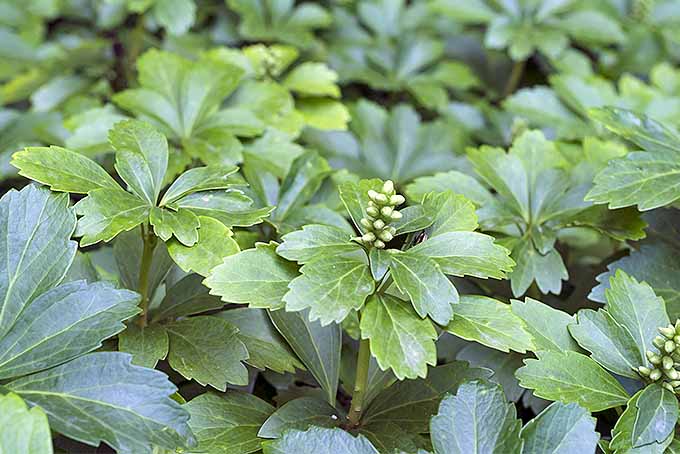
As a kid, I helped one neighbor gather a bucketful of cuttings from another neighbor to plant under a large tree with distressed, sprawling roots, and bare soil.
Those cuttings took root almost immediately. Before long, there was a pretty bed of glossy green whorled (i.e. spiraled) leaves that not only hid the tree roots, but protected them from further lawnmower damage. In April, spikey white blossoms made for an added attraction.
If you’re in Zones 5 to 9 and looking for a fast-growing option, this could be the one. It’s drought tolerant, does best in part to full shade, and reaches a height of about 12 inches.

Nature Hills offers Japanese spurge (P. terminalis ‘Green Sheen’) in one-gallon pots.
10. Liriope (Liriope spicata)
Liriope is also known as lily turf. I have this hardy perennial beneath my front garden rosebush. It’s a grass-like plant with clumping and creeping varieties that may reach one to two feet in height.
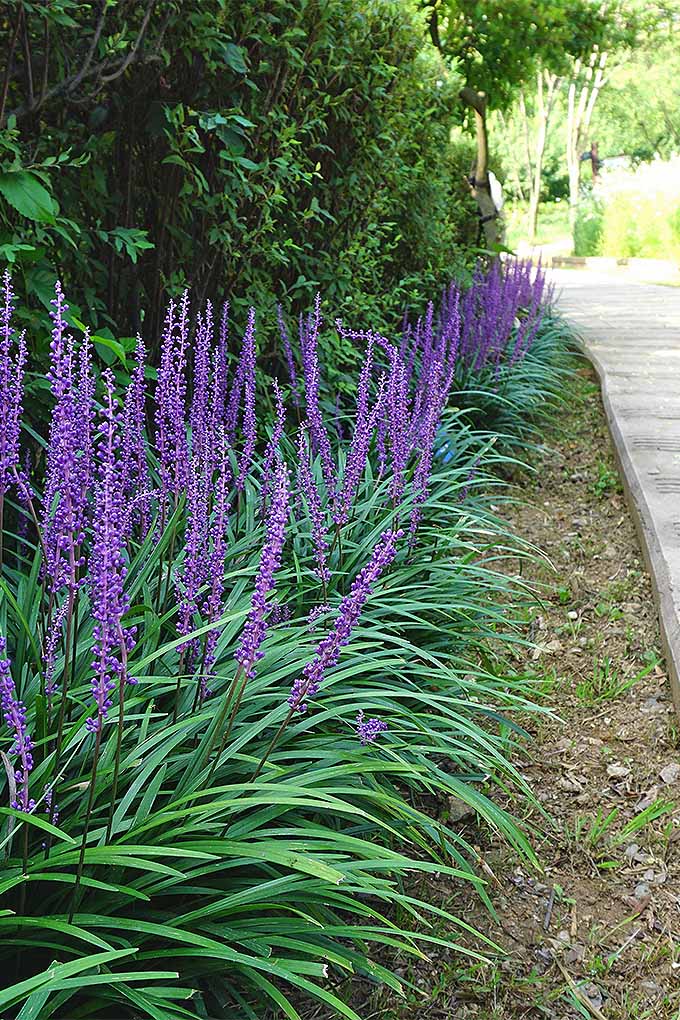
Spikes of tiny blossoms in shades of blue, white, or purple appear in August and September. Some have green foliage, while others are variegated.
Liriope thrives in sun as well as shade, and likes moist, rich soil. It’s suitable for Zones 5 to 10. I’m in Zone 6, and mine turn brown in the winter and freshen up in spring.
Liriope makes pretty garden borders and is good at inhibiting erosion on slopes. It’s great under trees where you just can’t seem to get the grass to grow.
Nature Hills offers L. spicata, a creeping variety, in one-gallon pots.
11. Lithodora (Lithodora diffusa)
I recently planted my first lithodora. It was the tiny, bright blue blossoms that caught my eye at the nursery.
It likes part shade, particularly in hot regions, and must have well-drained soil.
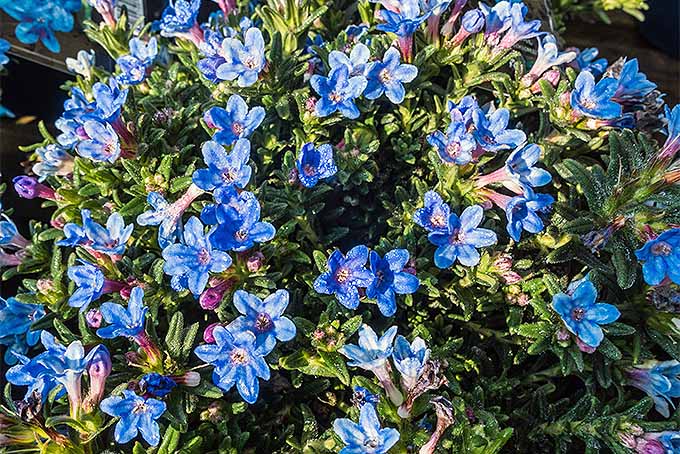
Great for Zones 6 to 8, and able to withstand light foot traffic, this plant may reach 12 inches in height. It has small, hairy “sessile” green leaves that are attached without stalks, making for a low profile.
Lithodora blooms vigorously in May, then occasionally through August. In temperate zones, it is a perennial.
I’m on the annual/perennial cusp, so if I layer my plant well with mulch and we have a mild winter, it should return next spring.
One thing I learned quickly with this plant is that it won’t spread out and naturalize if it has competition from native weeds and wildflowers.
Be sure to give your new ground covers room to grow. Once established, their matted root networks should squeeze out the competition.
You can find Lithodora ‘Heavenly Blue’ available from Nature Hills Nursery.
12. Pig Squeak (Bergenia cordifolia)
Pig squeak is a perennial whose name comes from the squeaky sound the leaves make when you rub them between your fingers. It’s suitable for Zones 3 to 8, and grows best in part to full shade.

Pig squeak is a clumping plant with shiny, dark green leaves and stalks of pink blossoms that bloom in April and May. It’s a slow-grower that may exceed 12 inches in height. This plant is drought tolerant.
Nature Hills offers Pig Squeak ‘Winter Glow’ in five-inch pots.
Read more about growing bergenia here.
13. Spike Speedwell (Veronica spicata)
Spike speedwell, often called royal candles, is a clumping perennial suitable for Zones 3 to 8.
Its narrow green leaves form a base for tall spikes comprised of tiny blossoms in shades of purple, blue, pink, or white. Bloom time is June through August.
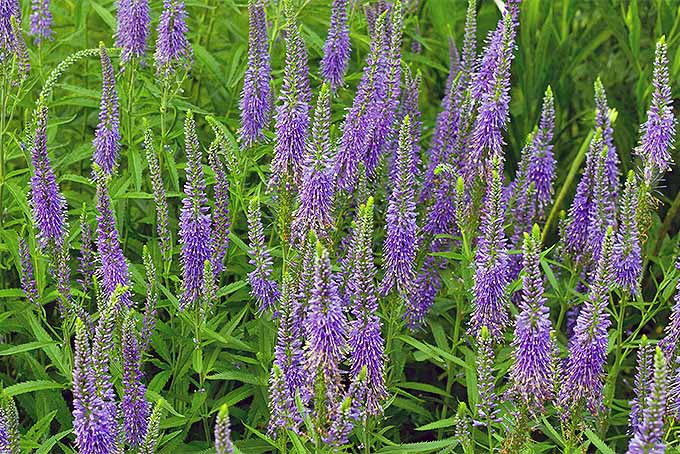
Spike speedwell prefers full sun and moist, well-drained soil. It grows to a foot or more in height. Multiple plantings merge into a vibrant swath of color.
True Leaf Market offers V. spicata ‘Blue Bouquet’ seeds in packages of 100 and 500.
14. Sweet Woodruff (Galium odoratum)
Sweet woodruff is a fragrant perennial with star-like white blossoms atop whorled (spiraled) green leaves. It blooms during the months of May and June.

Perfect for Zones 4 to 8, sweet woodruff prefers part to full shade and moist, well-drained soil. It tops out at approximately eight inches, and naturalizes rapidly. This variety is great as an underplanting beneath shrubs.
Sweet woodruff is one of my favorites, as I’m a fan of woodland gardening with shade perennials.

You can find packets of 20 seeds available from Seedville via Amazon.
15. Wishbone Flower (Torenia fournieri)
Wishbone flower, also called bluewings or clown flower, is an annual that grows best in part to full shade.

Suitable for Zones 2 to 11, it likes moist, well-drained soil. The blossoms of wishbone are trumpet-shaped in shades of purple, pink, white, and yellow, often with contrasting “throats.” Leaves are light green and oval.
Wishbone is desirable for its ability to produce vibrant color all summer, in the shadiest portions of a garden.
True Leaf Market offers 25-, 100-, and 500-seed packets of multicolored Kauai mix.
Carpets of Color
Ground covers are a versatile garden choice. They’re perfect for irregular terrain, and make an attractive alternative to a sea of green grass.
In addition, when planted beneath ornamental shrubs, they make a useful weed barrier.
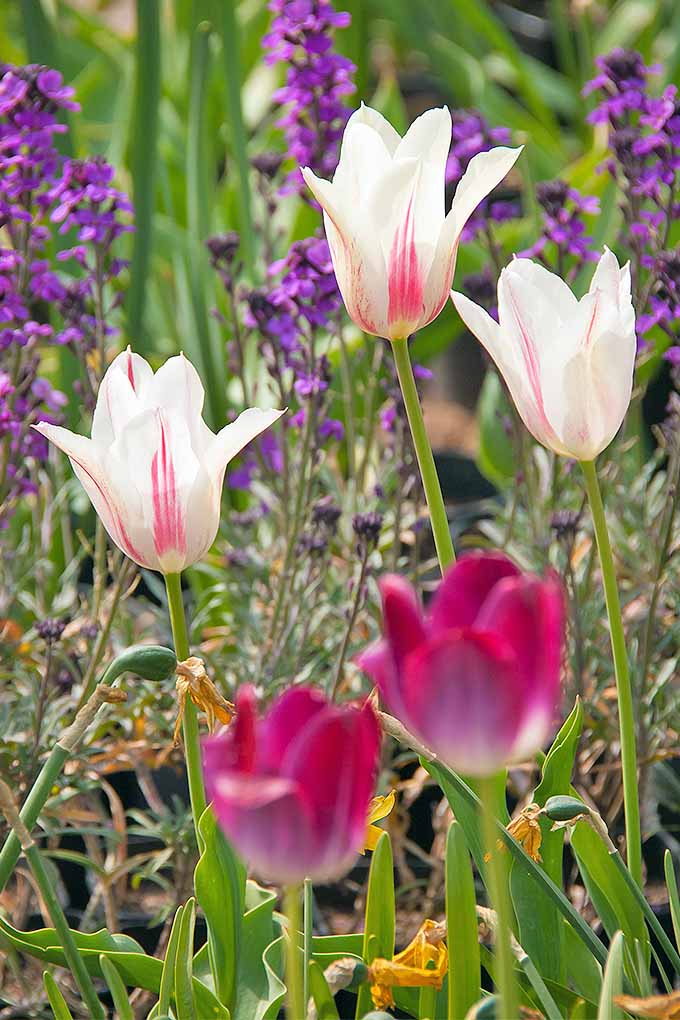
Do you love spring bulbs, but hate the unsightly withering greens that follow blooming?
Try growing bulbs right through a patch of speedwell or pachysandra, and their fading post-bloom foliage won’t be as noticeable.
When selecting plants, keep in mind that native types are the most vigorous and require the least maintenance. Consider mixing varieties to achieve an appealing palette of color, texture, and height.
And remember that evergreens provide winter interest, while deciduous varieties disappear completely during the cold months.
Pay close attention to descriptions of plant heights as you make your selections. You don’t want to shop for a ground-hugger to plant between paving stones and come home with a two-foot spike variety!
I love the ground cover plants that meander through my property. Now it’s your turn to create a feast for the eyes with rich and varied carpets of color.

Which plants will you choose?
We love to hear from our readers. Tell us in the comments below how flowering ground covers play a feature role in your landscape.
Looking for more perennial flower suggestions? Try these guides next:


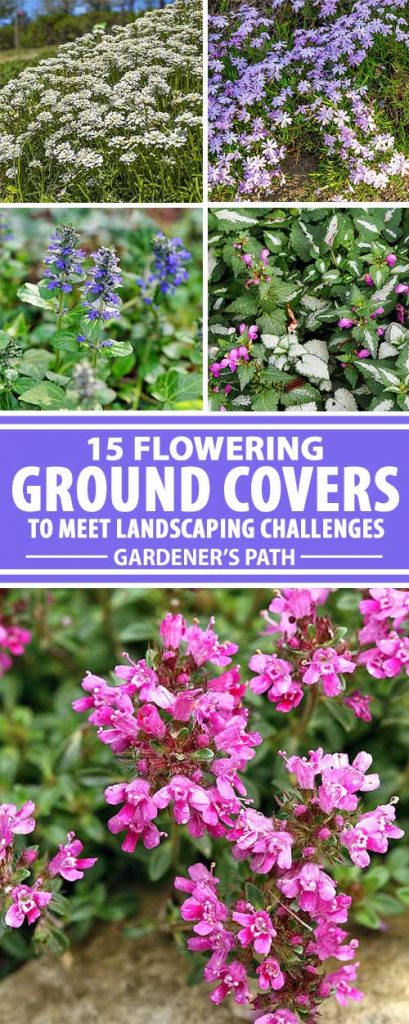

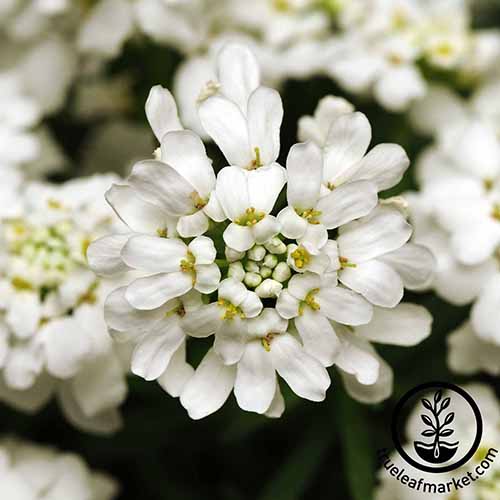
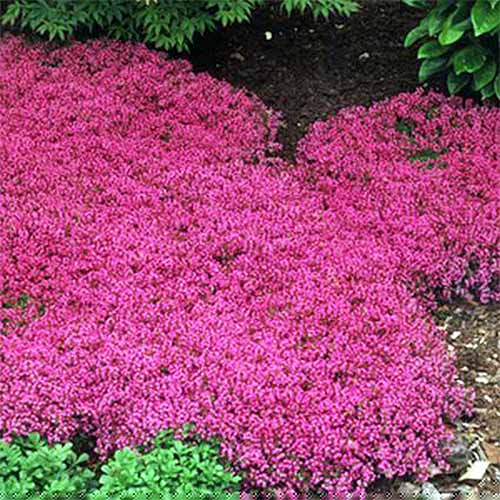
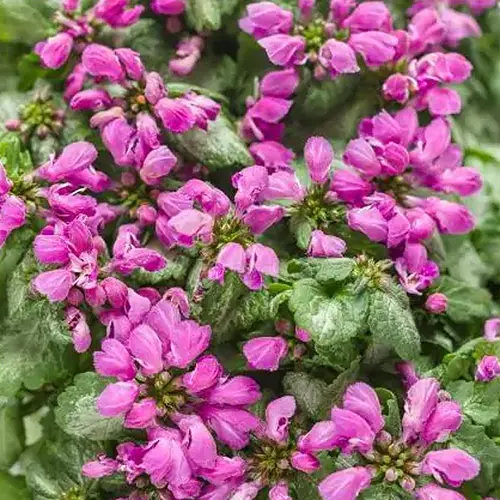

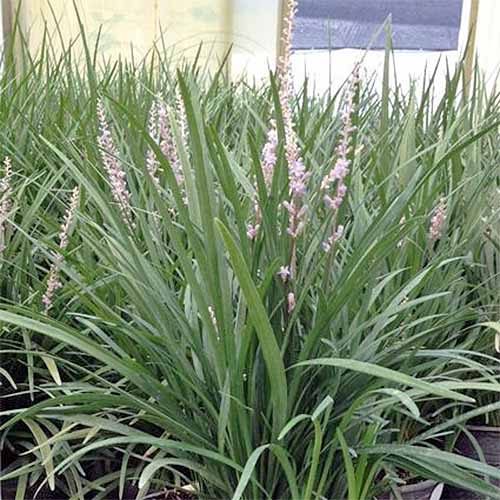
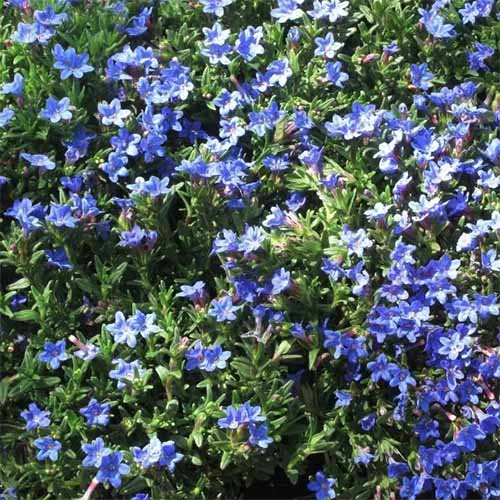


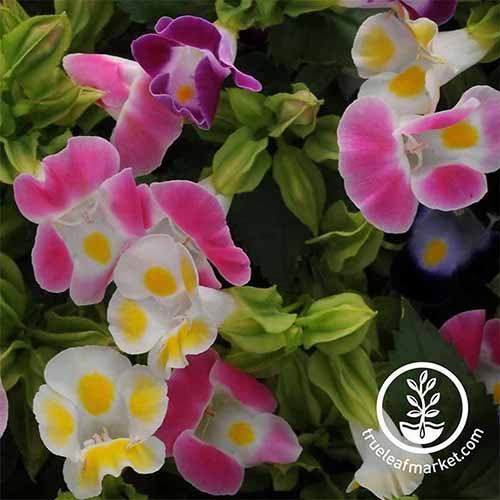
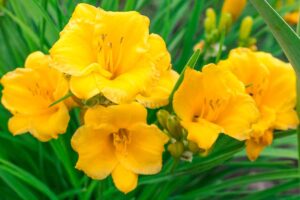

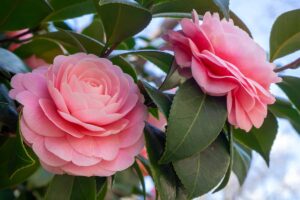
what are the little blue flowers (ground cover) currently growing wild along w/the snow drops? They have six petals.
Thanks for your question, Mary. If they were purple rather than blue, my best guess would be crocus, though I’d describe those as more purple than blue. It’s hard to say what they might be without more information, but we’d love to help you to identify these flowers! Where are you located? Feel free to send a photo via email or our Facebook page.
Periwinkle.
I would love to ask such an experienced person. I have a creek with steep (60%) slope, shady. How to hold the dirt falling into the creek and put some nice grass green all year round?
Hi Viktorija, I think you’re trying to fight a losing battle there. I’ll let Nancy and Matt Suwak (our resident landscaper) weigh in, but grass requires sun. Even those seed mixes advertised for shady areas require a good amount of sun-hours to be vigorous. I would plant a a single species or a mix of shade tolerant ground covers instead. Something like: #6. dead nettle 7. hosta 9. Japanese pachysandra 14. sweet woodruff or 15. wishbone flower. Grass just isn’t designed for the shade having evolved on plains and savanna. You can get some more ideas in our shade category:… Read more »
Hackenakloa Japanese forest grass likes shade and is beautiful although a bit slow growing, lawn fertilizer speeds it up.
Monkey grass.
No. 2? Looks more like a wild strawberry, than it does a Canadian Anemone.
You’re right, B. Thanks for bringing this error to our attention! We’ve replaced this image with a new one. Unfortunately, the original must have been mislabeled. Our mistake.
Hi! I came across this article on ground cover and thought I would ask for some help identifying a type of ground cover we saw and are interested in using. I have included 3 photos of it. Any idea what it is called? Thanks in advance!
This is Vinca minor, or periwinkle. It does well in the shade, and spreads readily!
My recent experience with Vinca is that it’s almost impossible to get rid of without physically digging it up as I had to! Keep that in mind when you plant it and make sure that you put it in area where you don’t mind a carpet of green. If you have an area of your yard where you don’t want to mow, Vinca might be a good choice because it’s maintenance free and keeps the soil in place. Maybe the person who was looking for something to plant near a stream bank (Victorija?) could consider this. Basically, put the Vinca… Read more »
How do you eradicate it? It has taken over my front beds, yard and everything in the back. The roots grow deep and attach to everything it comes in contact with. I’m thinking that’s what I have also. Does it also have white flowers. If so, then maybe that’s what I have..
Vinca minor usually has pale blue or purplish flowers, but varieties are available in white as well. It can certainly be hard to eradicate once established! You can pull it out by the roots when the ground is moist. Be sure to dig deep, at least six inches down, sometimes as far as several feet. You will need to remove all of the roots and plant material to keep it from coming back. This can be a painstaking process, and some gardeners choose to apply an oil-based herbicide instead. But keep in mind that this can be damaging to other… Read more »
Does anyone know the name of the plant in the second photo in this article, before Bugleweed is discussed?
Hi Paula, it’s #12, Pig Squeak (Bergenia Cordifolia). Just without the blooms.
Paula, it’s #12, Pig Squeak (Bergenia Cordifolia). Just without the blooms.
Thanks!
Thank you for your article. Can you identify this low growing perennial that my friend bought at a farm?
My best guess is a narrow leaf variety of artemesia, however it also resembles an annual frequently used in “instant color” pre-planted patio pots and mixed hanging baskets in place of trailing pertunias or purple wandering jew.
My husband just put in new sod in our front yard. In order not to have to weed eat up to the rock wall border he left a space for a ground cover. We live in eastern North Carolina. The area is sunny in the morning, shady in the afternoon. What ground cover would you suggest that would add ornamental color, low maintenance and not take over the yard? It has to be deer resistant.
Ceratostigma plumbaginoides – Leadwort, Hardy Plumbago – grows in sun or shade, doesn’t need lots of water, weed resistant as well. Bright cobalt blooms in late summer, bronze fall foliage. Slow to fill out in the spring – so I underplant with crocus and tulips. Love the stuff, wish it would spread just a little faster.
We live near Napa Ca. In our yard we have a 30 foot circumference circle that was recently cleared looks horrible want to plant spread some seed to cover the circle with something that will last and look good all year long. It is in a high visible area that needs something that looks really good. Ideas?? What can I plant now in winter?
Hello Robert –
With your sunny, dry weather, you might like Salvia ‘Bee’s Bliss’. This is a type of creeping sage with fragrant purple flowers and edible leaves. Mature dimensions range from 1 to 3 feet tall and 5 to 8 feet wide. It has low water needs and tolerates drought well. The growth rate is moderate to fast. The ground temperature should be at least 65°F for planting.
Question: we live in Virginia in zone 6. We are looking for a flowering ground cover that doesn’t require a ton of water since we are on a well. We live in the woods with mostly sun throughout the day. We have a bank on the side of our driveway where we planted shrubs but want to fill in the area also with ground cover. Any suggestions?
Will creeping they grow and how much should I plant for an area 60 feet long by 20 feet wide?
Hi Terry – You might like to try Vinca minor, commonly called periwinkle. It’s the topic of several of our discussions here. Periwinkle is suited to your zone, prefers shade but can grow in sun, controls erosion on banks, and does well beneath shrubbery. Its watering needs are considered dry to average. I’ve grown it for years in shady gardens, and find it to be an excellent ground cover. As for the math, each plant may spread to 18 inches wide. The recommended spacing is 12 to 18 inches apart. You may plant them closer together, but you run the… Read more »